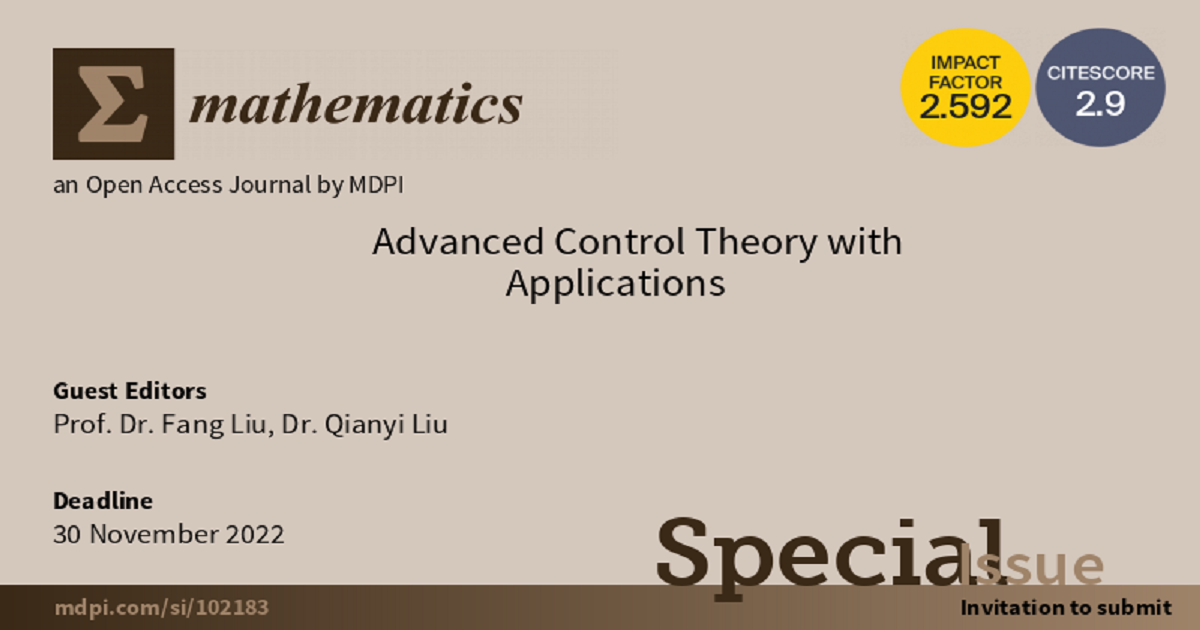Advanced Control Theory with Applications
A special issue of Mathematics (ISSN 2227-7390). This special issue belongs to the section "C2: Dynamical Systems".
Deadline for manuscript submissions: closed (31 March 2023) | Viewed by 52108

Special Issue Editors
Interests: smart grid; time-delay systems; deep learning; advanced control algorithm
Special Issues, Collections and Topics in MDPI journals
Interests: new distribution systems; power quality; distributed generation; energy storage
Special Issues, Collections and Topics in MDPI journals
Special Issue Information
Dear Colleagues,
Control theory with application pertains to the study of control and decision technology and its application in complex, dynamic and interconnected systems. Control theory with application has witnessed dramatic achievements, which play a central role in most applications, such as smart grids, power systems, aerospace, robotics, intelligent transportation systems, etc. The establishment of mathematical models and the design of control methods are particularly important. The aim of this Special Issue is to explore and disseminate the latest research and development in the application of control theory and control technology to industrial production. We are looking for original papers with novel research contributions in all aspects of control theory that have relevance and impactful applications. Topics of interest include, but are not limited to:
- Methods of networked control systems;
- Methods of time-delay control systems;
- Multi-agent control system;
- Application of artificial intelligence technology in control theory;
- Methods of analysis and synthesis of control modes;
- Methods of numerical simulation for control systems;
- Complex problems of intelligent modeling and control systems;
- Application of advanced control theory in smart grid;
- Operation and optimization of power system.
High-quality research and surveys reflecting the current state of affairs are welcome. Particular attention should be paid to the practical application of research results.
Prof. Dr. Fang Liu
Dr. Qianyi Liu
Guest Editors
Manuscript Submission Information
Manuscripts should be submitted online at www.mdpi.com by registering and logging in to this website. Once you are registered, click here to go to the submission form. Manuscripts can be submitted until the deadline. All submissions that pass pre-check are peer-reviewed. Accepted papers will be published continuously in the journal (as soon as accepted) and will be listed together on the special issue website. Research articles, review articles as well as short communications are invited. For planned papers, a title and short abstract (about 250 words) can be sent to the Editorial Office for assessment.
Submitted manuscripts should not have been published previously, nor be under consideration for publication elsewhere (except conference proceedings papers). All manuscripts are thoroughly refereed through a single-blind peer-review process. A guide for authors and other relevant information for submission of manuscripts is available on the Instructions for Authors page. Mathematics is an international peer-reviewed open access semimonthly journal published by MDPI.
Please visit the Instructions for Authors page before submitting a manuscript. The Article Processing Charge (APC) for publication in this open access journal is 2600 CHF (Swiss Francs). Submitted papers should be well formatted and use good English. Authors may use MDPI's English editing service prior to publication or during author revisions.
Keywords
- time-delay systems
- networked control systems
- multi-agent
- artificial intelligence methods
- intelligent modeling
- iIntelligent control
- smart industrial
- smart grid
- optimization
Benefits of Publishing in a Special Issue
- Ease of navigation: Grouping papers by topic helps scholars navigate broad scope journals more efficiently.
- Greater discoverability: Special Issues support the reach and impact of scientific research. Articles in Special Issues are more discoverable and cited more frequently.
- Expansion of research network: Special Issues facilitate connections among authors, fostering scientific collaborations.
- External promotion: Articles in Special Issues are often promoted through the journal's social media, increasing their visibility.
- Reprint: MDPI Books provides the opportunity to republish successful Special Issues in book format, both online and in print.
Further information on MDPI's Special Issue policies can be found here.






